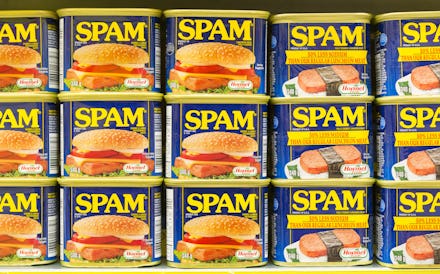Why this health-conscious chef considers Spam the ultimate comfort food

I grew up eating Spam.
Sort-of-probably-almost meat. Spam.
So did most Korean-Americans I grew up with. We represent the “Spam generation,” sons and daughters of refugees from a war-torn Korea, who developed a taste for this canned salty meat introduced to our parents through army rations.
Invented in 1937 by Hormel Foods, Spam was a cheap and shelf-stable meat source embraced by hungry families and soldiers. It was known as a wartime delicacy and remained a much sought-after product throughout Asia. You can buy ornate Spam gift boxes showcasing glorious cans next to artisan bottles of cooking oil. It is a luxury item and commonly gifted for weddings, and in Korea, it’s the ultimate present during Chuseok (Korean Thanksgiving).
Currently, Spam is sold in 44 countries around the world, but South Korea’s love for Spam surpasses them all, with the greatest consumption outside of the USA. In 1987, Hormel licensed Spam to CJ CheilJedang in Korea, solidifying its footprint in the country.
Why does South Korea, a country of 51 million people, embrace Spam so enthusiastically? I think it’s because Spam goes so well with kimchi, a spicy fermented cabbage side dish that’s the cornerstone of Korean cuisine and eaten at every meal. Its spicy, sour, salty, tart flavor profile marries beautifully with Spam’s porky “spaminess.”
My mom still makes kimchi fried rice studded with nuggets of Spam. She also throws a few slices in her kimchi jjigae (stew) to add richness. And she is not alone: Koreans incorporate Spam into many traditional dishes, like kimchi bokkeum (stir fried kimchi). Budae-jjigae, also known as “army stew,” was born from the necessity of stretching army rations by throwing them into a bubbling spicy broth — American cheese, baked beans, pasta, noodles, Vienna sausages and the key ingredient, Spam. A version of gimbap, a quintessential picnic food, rolls Spam up next to traditional veggies and American cheese.
When I was small, my after-school snack was a small bowl of rice mixed with water and bite-sized pieces of kimchi and Spam. I loved it, and remember strategically placing pieces of kimchi and Spam atop my spoon to ensure every bite had that Spammy flavor. Breakfast in our house was commonly eggs and Spam instead of ham.
I did not realize that Spam was ridiculed by the general public in the U.S. until my mom started packing Spam sandwiches for my school lunch. Crispy, fried, thick slices of Spam with a little caramelization, blanketed with slices of American cheese and nuzzled between two slices of fluffy white bread. I loved it but found myself the target of ruthless teasing, and my Spam sandwich days came to an abrupt end.
I started to shun Spam as I grew older and stopped eating it for many years, especially when I became more health-conscious and avoided many processed foods. But whenever I came home to New Jersey to visit my parents, I would see that iconic blue and yellow tin can in their pantry beckoning me.
During my last visit, I looked at the can more closely. It no longer has the fun turn-key on the bottom to help open the can. Albeit hazardous, I do remember having fun trying to thread the thin strip of metal on the side through the key hole, and then twisting it all around the can and creating a long, sharp, springy coil that could slice your finger off. A mundane pull tab now gets the job done in seconds. In Korea, Spam cans also now have a convenient yellow plastic lid, to keep it “fresh,” and comes in many different flavors, including teriyaki, cheese and jalapeño.
I asked Esther Choi, chef and owner of Mokbar in New York City, what her thoughts on Spam were. “Spam is a genius product. I always have a few cans at home. I use it in my budae-jjigae at Mokbar too,” she said.
She further explained: “You can’t have budae-jjigae without Spam. And, I’m not ashamed to love Spam. It is the best pan-fried with an egg on rice, or in kimchi jjigae.”
Simon Kim, owner and general manager of Cote Korean barbecue in New York City, said that he eats Spam as well. He passionately described how slicing Spam to the “right” thickness is crucial.
“It can’t be too thin, or too thick. You want it crispy, with enough firm juiciness inside,” Kim said. “Slice it too thick and it’s too soft and mushy in the middle.”
Back at my parent’s home in Berkeley Heights, New Jersey, I pried open a can. I pulled the gelatinous pink block out of the can onto a cutting board, and sliced a few pieces a little thinner than one centimeter. I heated up a frying pan with a slick of oil and fried the slices until they were crispy golden brown around the edges. I placed the Spam on top of a mound of steaming white rice and then a soft fried egg. I added some kimchi for good measure and dug in.
I had forgotten how good Spam really was. I was transported back to the days of my after-school snacks and the many homemade dishes my mom made. And this little bowl of just four ingredients was so satisfying. The rice balances the saltiness of the Spam perfectly, while the egg adds a touch of creaminess that blends beautifully. And the kimchi provides a tart crunchy freshness to finish.
I finished the bowl, completely intrigued. And with my curiosity piqued, I looked up what Spam stands for on its website.
Apparently, Spam is short for Sizzle, Pork and Mmm.
I’d have to agree.
Judy Joo is a Korean-American chef who runs Jinjuu restaurant in London and Hong Kong. She hosts Cooking Channel’s ‘Korean Food Made Simple,’ and is the author of a cookbook of the same name.